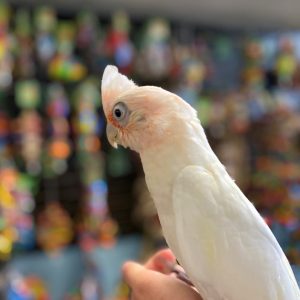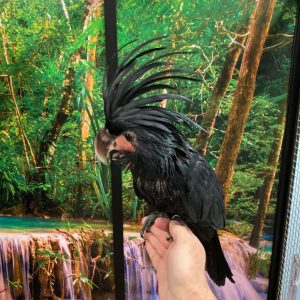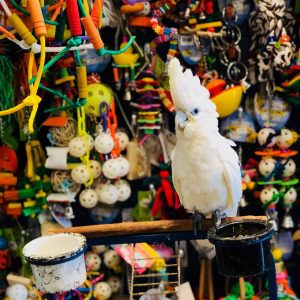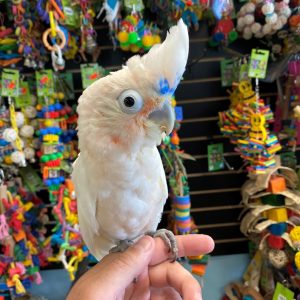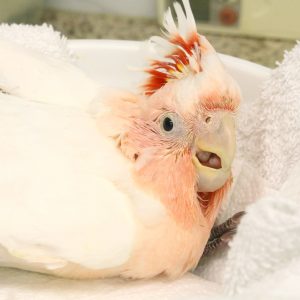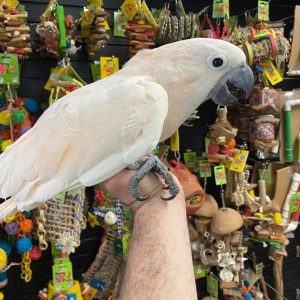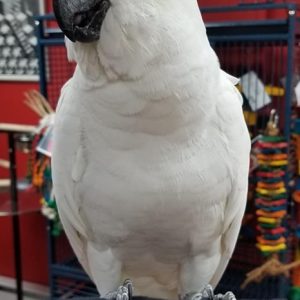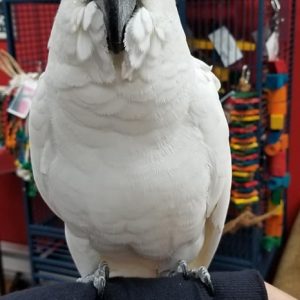Cockatoos for Sale
Cockatoos for Sale
The Cockatoos are one of the most favored birds as pets in the Parrot family. They are beautiful birds possessing striking talking abilities. Cockatoos are extremely beautiful, loving, and social creatures, portraying an intelligent, playful, inquisitive, and enchanting self.
Most Cockatoos are white in color, but others come in grays and pinks, blacks, and deep blue in the Palm’s case.
Origin of the Cockatoo
Native to Australia, Papua New Guinea, and Indonesia, there are over 40 species of the Cockatoo.
Lifespan
The average lifespan is about 40 years for smaller birds like the Goffin’s Cockatoo. The larger cockatoos, like Moluccan species, have a longer lifespan of about 80 years.
Physical Appearance
There are about 21 species of cockatoos in the world. While most of these are white in color, some come in shades of gray, pink, black, and deep blue. These birds are native to the Indonesian Islands and make for excellent pets.
We have hand-raised and tamed cockatoos for sale, including the Bare Eyed Cockatoos, Black Palm Cockatoos, Ducorp Cockatoos, Goffin Cockatoos, Sulpher Crested Cockatoos, Major Mitchell Cockatoos, Moluccan Cockatoos, Rose Breasted Cockatoo, Umbrella Cockatoos.
Their size differs from one species to another, while the lesser sulfur-crested Cockatoo and Goffin’s Cockatoo are the smallest of the lot, the Moluccan Cockatoo, greater sulfur-crested Cockatoo, and the umbrella cockatoo are the largest.
Temperament
Cockatoos are lively, affectionate birds. They are quite cuddly and bond very closely with their owners. However, their sociability and need for affection mean they demand a great deal of time from their owners. Deprived of love, cockatoos will become depressed or exhibit neurotic behaviors. They are intelligent, playful, mischievous, and can be exceptionally loud. They are somewhat excitable, and sometimes they do not mix well with young kids. A cockatoo’s powerful beak can injure small, prodding hands.
Diet:
A healthy Cockatoo diet consists of a large variety of fresh vegetables, fruit, and nuts. As well as cooked grains such as barley, oats, brown rice, vegetable pasta, and sweet potato. Pellets* and a small amount of seed should be included at least several times a week.
Cockatoos will happily feast on fresh vegetables, grains, fruits, etc. You can also include bird pellets in their diet. You will have to be careful when feeding seeds and seed mixes as they are high-fat content. Nuts can be given as a special treat. Never give them chocolates, fried foods, alcohol, or salted foods, like potato chips, pretzels, etc.
Cockatoos are somewhat like humans in behavior; in a sense, they need a lot of love. They are compassionate, so make sure you don’t neglect them in any way.
Cage Size:
The bigger the cage, the better. Large Cockatoo’s, such as Umbrella’s and Moluccan’s, should have a cage 40″ wide x 30″ deep at minimum. Smaller cockatoos such as the Goffin’s and Ducorps can get by with a cage 36″ wide x 24″ deep, but again bigger is always better! I recommend 40″ wide x 36″ deep for ALL size Cockatoos. They love the space, and this allows lots of room for toys and perches.
As far as housing requirements are concerned, you need to have a cage that is not smaller than a 24″ x 36″ x 48″ in size. It should have a bar spacing of ¾” to 1″. If you have a large cockatoo, you will need a cage of about 24″ x 48″ x 48″ and bar spacing of about 1″ to 1.5″. You should buy strong cages made of wrought iron, stainless steel, etc., as cockatoos have a very tough beak.
You should give your bird lots of toys to play with. They are aggressive chewers and love to destroy things. Therefore, giving them softwood toys, tanned vegetable leather, ropes, bells, and even cardboard to play with makes sense. Their toys should include hanging toys and those that the bird can pick up with its beak.
Exercise:
A cockatoo should be allowed plenty of opportunity for exercise. 3 to 4 hours a day outside of the cage is ideal. If not practical, then at least an hour on a Play Gym with time allowed interaction with people.
Cockatoos for Sale
The Cockatoos are one of the most favored birds as pets in the Parrot family. They are beautiful birds possessing striking talking abilities. Cockatoos are extremely beautiful, loving, and social creatures, portraying an intelligent, playful, inquisitive, and enchanting self.
Most Cockatoos are white in color, but others come in grays and pinks, blacks, and deep blue in the Palm’s case.
Origin of the Cockatoo
Native to Australia, Papua New Guinea, and Indonesia, there are over 40 species of the Cockatoo.
Lifespan
The average lifespan is about 40 years for smaller birds like the Goffin’s Cockatoo. The larger cockatoos, like Moluccan species, have a longer lifespan of about 80 years.
Physical Appearance
There are about 21 species of cockatoos in the world. While most of these are white in color, some come in shades of gray, pink, black, and deep blue. These birds are native to the Indonesian Islands and make for excellent pets.
We have hand-raised and tamed cockatoos for sale, including the Bare Eyed Cockatoos, Black Palm Cockatoos, Ducorp Cockatoos, Goffin Cockatoos, Sulpher Crested Cockatoos, Major Mitchell Cockatoos, Moluccan Cockatoos, Rose Breasted Cockatoo, Umbrella Cockatoos.
Their size differs from one species to another, while the lesser sulfur-crested Cockatoo and Goffin’s Cockatoo are the smallest of the lot, the Moluccan Cockatoo, greater sulfur-crested Cockatoo, and the umbrella cockatoo are the largest.
Temperament
Cockatoos are lively, affectionate birds. They are quite cuddly and bond very closely with their owners. However, their sociability and need for affection mean they demand a great deal of time from their owners. Deprived of love, cockatoos will become depressed or exhibit neurotic behaviors. They are intelligent, playful, mischievous, and can be exceptionally loud. They are somewhat excitable, and sometimes they do not mix well with young kids. A cockatoo’s powerful beak can injure small, prodding hands.
Diet:
A healthy Cockatoo diet consists of a large variety of fresh vegetables, fruit, and nuts. As well as cooked grains such as barley, oats, brown rice, vegetable pasta, and sweet potato. Pellets* and a small amount of seed should be included at least several times a week.
Cockatoos will happily feast on fresh vegetables, grains, fruits, etc. You can also include bird pellets in their diet. You will have to be careful when feeding seeds and seed mixes as they are high-fat content. Nuts can be given as a special treat. Never give them chocolates, fried foods, alcohol, or salted foods, like potato chips, pretzels, etc.
Cockatoos are somewhat like humans in behavior; in a sense, they need a lot of love. They are compassionate, so make sure you don’t neglect them in any way.
Cage Size:
The bigger the cage, the better. Large Cockatoo’s, such as Umbrella’s and Moluccan’s, should have a cage 40″ wide x 30″ deep at minimum. Smaller cockatoos such as the Goffin’s and Ducorps can get by with a cage 36″ wide x 24″ deep, but again bigger is always better! I recommend 40″ wide x 36″ deep for ALL size Cockatoos. They love the space, and this allows lots of room for toys and perches.
As far as housing requirements are concerned, you need to have a cage that is not smaller than a 24″ x 36″ x 48″ in size. It should have a bar spacing of ¾” to 1″. If you have a large cockatoo, you will need a cage of about 24″ x 48″ x 48″ and bar spacing of about 1″ to 1.5″. You should buy strong cages made of wrought iron, stainless steel, etc., as cockatoos have a very tough beak.
You should give your bird lots of toys to play with. They are aggressive chewers and love to destroy things. Therefore, giving them softwood toys, tanned vegetable leather, ropes, bells, and even cardboard to play with makes sense. Their toys should include hanging toys and those that the bird can pick up with its beak.
Exercise:
A cockatoo should be allowed plenty of opportunity for exercise. 3 to 4 hours a day outside of the cage is ideal. If not practical, then at least an hour on a Play Gym with time allowed interaction with people.
Showing all 9 results

